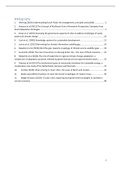Summary
Summary of all required literature: Cities, Water & Climate Change
- Course
- Institution
Literature included in summary is as following: 1. Wiering (2019) Understanding Dutch Flood risk management, principles and pitfalls 2. Keessen et al (2013) The Concept of Resilience from a Normative Perspective: Examples from Dutch Adaptation Strategies 3. Koop et al. (2017) Assessing the gov...
[Show more]



